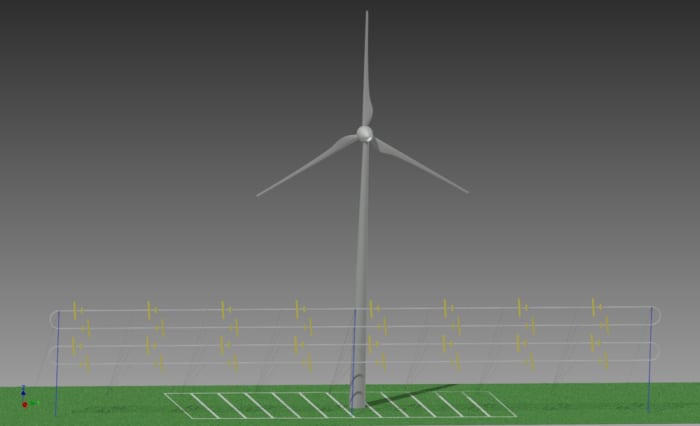A simple, flexible, innovative design to capture wind energy at a fraction of the price, the AirLoom has the potential to disrupt the entire (not just renewable) electricity generation market.
The AirLoom dramatically reduces the capital cost of wind turbines by an astounding 15X over the dominant wind technology, the horizontal axis wind turbine (HAWT). It captures large swept areas of wind at low cost by placing multiple airfoils on a vertical oval track, with all forces distributed and supported by tension cables. The AirLoom’s patented design represents a 23X reduction in the HAWT’s mass, resulting in a dramatic reduction in manufacturing, transportation, maintenance and land costs.
Although the AirLoom doesn’t look much like a HAWT, it uses the same aerodynamics. It captures energy through translational rather than rotational motion in the tips of the airfoils as they run along a rail tethered by bridles. The small airfoils behave exactly like the outer tips of a HAWT airfoil, which are the components that do all the work in a HAWT. The patented bridling system handles downwind forces (aerodynamic “tip-over” forces), which are the primary cause of the HAWT’s mass and cost. The bridles tether the oval track to the ground, absorbing the forces as the airfoils travel around the track. Because the forces are distributed rather than concentrated—and because they are handled by components in tension (cheap, light) rather than compression (expensive, heavy)—each bridle can be small, lightweight, and inexpensive.
Another major innovation is to run airfoils in an oval rather than a circle. This alters the math behind swept area, the key input for generation capacity. Because its swept area is a function of length and height, rather than radius squared, an AirLoom can add capacity in many different ways. Conversely, if the most important criterion is to get at faster wind at a higher elevation, an AirLoom could be higher than the equivalent HAWT. For example, at a site with a 200-foot height restriction, a HAWT’s hub—the average elevation of its swept area—would be at 133 feet (twice the rotor radius). But an AirLoom at that site could have an oval spanning 140 to 190 feet; at 165 feet, the average elevation of its swept area is 24% taller than the HAWT. With the AirLoom, height is no longer a requirement but a design choice—a choice made to maximize the value of any given site.
The AirLoom would allow market and economic forces to drive achievement of the Department of Energy’s goal of 35% wind-powered electricity by 2050. Achieving that goal would eliminate more than 1,701 million metric tons of carbon emissions annually. With its radical cost and mass reductions, and far smaller carbon footprint, the AirLoom is poised to displace the HAWT to become the dominant technology in the wind energy market.
Video
Voting
-
ABOUT THE ENTRANT
- Name:Robert Lumley
- Type of entry:individual
- Profession:
- Robert is inspired by:Since 2007, Robert Lumley's enthusiasm for kiteboarding has drawn him into the study of wind power (as featured in the August 29, 2012 Wall Street Journal article, "Go Fly a Wind Turbine") —leading to the steady accumulation of ideas, patents, and a network of experts.
- Software used for this entry:Ansys Multiphysics
- Patent status:patented








